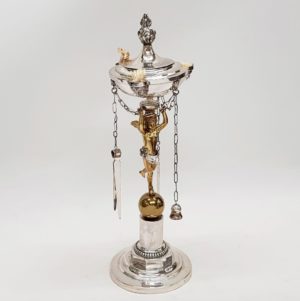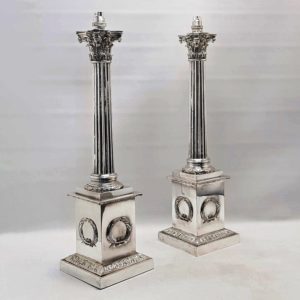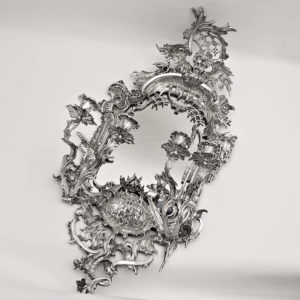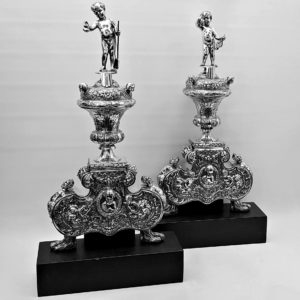Other Lighting
Other Lighting
Browse our collection of Other Lighting devices such as antique silver Oil Lamps, Wall Lights, Sconces, Lanterns and Chandeliers. Early lighting is as prized today as it was two centuries ago and can be used both inside and outside of the house.
The 17th and 18th century Lantern was very economical as it shielded the candle from the wind outside and from drafts when used inside the house, thus allowing the wax or tallow stick to burn more slowly and steadily. The archaic name, lanthorn, refers to the thin sheets of translucent horn used to fashion the sides of the early lanterns before they were made of glass.
Wall Sconces were wall lights with a back plate from which a ”branch” or candle socket extended. The back plate, usually of mirror glass or polished metal, reflected light back into a room and magnified the light from each candle. The back or wall plate also afforded some protection from drafts. The term itself comes from the old French word esconse, meaning lantern or hiding place and from the Dutch word, schans, for protection or cover.
The use of Oil Lamps dates back to ancient times and there are Greek and Egyptian lamps which date back to the 3rd century BC. The oil lamp was used as an alternative to candles and produced light continuously for a period of time using an oil-based fuel source. In small towns and rural areas they remained in use until well into the 20th century, until such areas were finally electrified and light bulbs could be used.
-


1830
9430 Antique Italian Silver Oil Lamp
Sold
An attractive antique silver lamp mounted on a gilt metal cherub column. The traditional style oil lamp has provision for 3 wicks and the cover has a bayonet fitting. Suspended on 3 long chains are the snuffer, knife and tweezer tools. Weighted base. Height 34cm. Diameter of base 11cm. Italian silver marks for Rome and makers mark for Filippo Pacetti circa 1830.
-


Circa 1840
10124 Antique Silver Plated Table Lamps
Sold
A handsome pair of 19th century antique silver on brass oil lamp bases, now mounted as electric table lamps. Excellent quality design with Corinthian capitals, tall reeded columns and square plinths applied with laurel wreaths. The bases retain their original cast iron stability weights. Early Victorian. Height 58cm (63cm with electrical fitting). Width of base 16.5cm. Circa 1840. Unmarked. These lamps are being sold as decorative items only and have no electrical wiring.
-


Circa 1900
9566 Antique Silver Plated Wall Lights
Sold
A stunning pair of antique wall mirrors of tall shaped form (girandoles), each mounted with two pairs of candle sconces. Decorated in the flamboyant rococo style, the scrolling high relief ornament has fretwork, sea foam and stalactites. Mounted at the top is a winged cherub and below the mirror is a figural plaque. Height 65 cm. Width 34 cm. Mirror height 30 cm, width 18 cm. Probably French. Circa 1900.
-


1916
Edward Barnard & Sons
9955 Charles II Style Antique Silver Chenets
Sold
An outstanding pair of George IV sterling silver cherub ornaments of substantial weight and presence. These silver andirons are in the 17th century style, after the models at Knowle. The vase shaped bodies support large cherub finials; one with a shovel, the other with a pair of bellows. The broad shaped bases, raised on claw feet, are chased in relief with busts and satyr masks amidst foliage. These andirons are raised on later, detachable and ebonised wood display plinths. Total weight of silver 7,664 grams, 246.3 troy ounces. Height 63.4cm, total height 73cm including the wooden stand. London 1916. Maker Edward Barnard & Sons. Sterling silver.